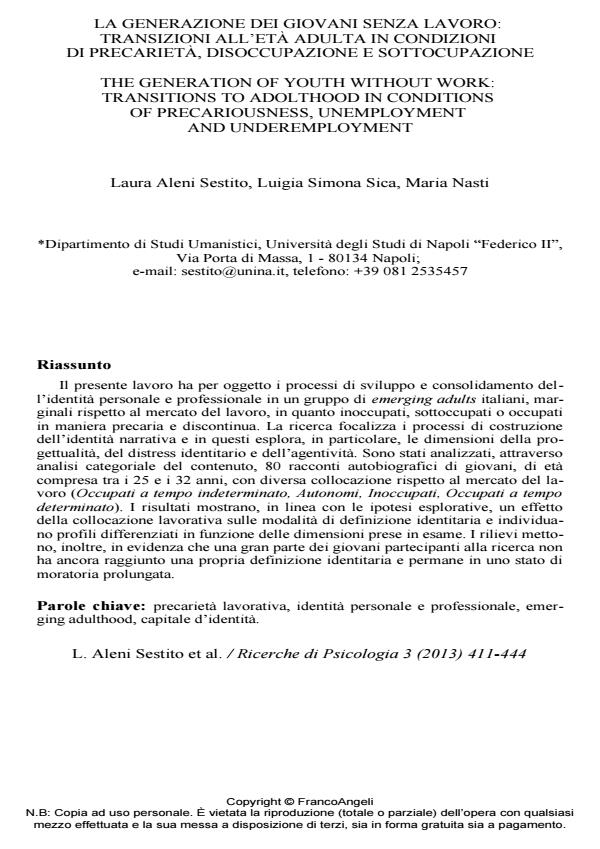La generazione dei giovani senza lavoro: transizioni all’età adulta in condizioni di precarietà, disoccupazione e sottocupazione
Titolo Rivista RICERCHE DI PSICOLOGIA
Autori/Curatori Sestito Laura Aleni, Luigia Simona Sica, Maria Nasti
Anno di pubblicazione 2014 Fascicolo 2013/3
Lingua Italiano Numero pagine 33 P. 411-443 Dimensione file 1853 KB
DOI 10.3280/RIP2013-003002
Il DOI è il codice a barre della proprietà intellettuale: per saperne di più
clicca qui
Qui sotto puoi vedere in anteprima la prima pagina di questo articolo.
Se questo articolo ti interessa, lo puoi acquistare (e scaricare in formato pdf) seguendo le facili indicazioni per acquistare il download credit. Acquista Download Credits per scaricare questo Articolo in formato PDF

FrancoAngeli è membro della Publishers International Linking Association, Inc (PILA)associazione indipendente e non profit per facilitare (attraverso i servizi tecnologici implementati da CrossRef.org) l’accesso degli studiosi ai contenuti digitali nelle pubblicazioni professionali e scientifiche
Il presente lavoro ha per oggetto i processi di sviluppo e consolidamento dell’identita personale e professionale in un gruppo di emerging adults italiani, marginali rispetto al mercato del lavoro, in quanto inoccupati, sottoccupati o occupati in maniera precaria e discontinua. La ricerca focalizza i processi di costruzione dell’identita narrativa e in questi esplora, in particolare, le dimensioni della progettualita, del distress identitario e dell’agentivita. Sono stati analizzati, attraverso analisi categoriale del contenuto, 80 racconti autobiografici di giovani, di eta compresa tra i 25 e i 32 anni, con diversa collocazione rispetto al mercato del lavoro (Occupati a tempo indeterminato, Autonomi, Inoccupati, Occupati a tempo determinato). I risultati mostrano, in linea con le ipotesi esplorative, un effetto della collocazione lavorativa sulle modalita di definizione identitaria e individuano profili differenziati in funzione delle dimensioni prese in esame. I rilievi mettono, inoltre, in evidenza che una gran parte dei giovani partecipanti alla ricerca non ha ancora raggiunto una propria definizione identitaria e permane in uno stato di moratoria prolungata.
Parole chiave:Precarieta lavorativa, identita personale e professionale, emerging adulthood, capitale d’identita.
- Raccontarsi ogni giorno: un intervento di orientamento universitario in itinere ispirato all'expressive writing e alla narrative vocational identity Luigia S. Sica, Laura Aleni Sestito, in RICERCHE DI PSICOLOGIA 4/2015 pp.607
DOI: 10.3280/RIP2014-004005 - Tra distress e agentività: il difficile percorso di consolidamento identitario nelle narrazioni di giovani adulti inoccupati o precari Simona Luigia Sica, Sestito Laura Aleni, in PSICOLOGIA DELLA SALUTE 1/2016 pp.111
DOI: 10.3280/PDS2016-001010 - Career development told through narrative research: exploring the stories of Italian and English young people Tiziana Di Palma, Hazel Reid, in International Journal for Educational and Vocational Guidance /2019 pp.129
DOI: 10.1007/s10775-018-9372-7
Sestito Laura Aleni, Luigia Simona Sica, Maria Nasti, La generazione dei giovani senza lavoro: transizioni all’età adulta in condizioni di precarietà, disoccupazione e sottocupazione in "RICERCHE DI PSICOLOGIA " 3/2013, pp 411-443, DOI: 10.3280/RIP2013-003002